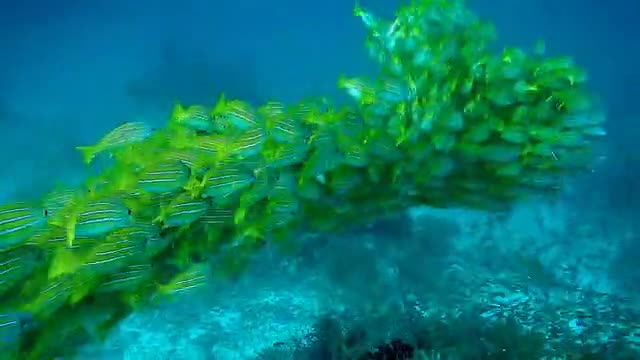Premium Only Content

Underwater life is so blessed 🐟🐟🐟| Yellow Tang Fish video 🐠🐠
Yellow fish: The yellow tang (Zebrasoma flavescens) is a saltwater fish species of the family Acanthuridae. It is one of the most popular marine aquarium fish. It is bright yellow in color, and it lives in reefs. The yellow tang spawn around a full moon. The yellow tang eats algae. The yellow tang has a white barb, located just before the tail fin, to protect itself.
Adult fish can grow to 20 centimetres (7.9 in) in length, and 1–2 centimetres (0.39–0.79 in) in thickness. Adult males tend to be larger than females. Yellow tangs are bright yellow in color. At night, the yellow coloring fades slightly, and a prominent brownish patch develops in the middle with a horizontal white band. They rapidly regain their bright yellow color during daylight. They can be aggressive, are prone to marine ich, and may damage coral within a reef tank. Male and female yellow tang look very similar. When mating, however, males change color and have a "shimmering" behavior which makes them identifiable. [6] The yellow tang has 5 dorsal spines along with 23-26 dorsal soft rays. The yellow tang also has 3 anal spines as well as 19-22 anal soft rays. There is a white spine on its caudal peduncle that it can use for defense. Its snout is moderately protruding. Its mouth is small with spatulate teeth that are place classed relatively close together inside of the yellow tang’s mouth. In juveniles, there are 12 upper and 14 lower teeth. In adults, there are 18 upper and 22 lower teeth.
The yellow tang is a marine fish that lives in reefs. The yellow tang is found by itself or in very small groups/schools. The yellow tang is mainly herbivorous and eats filamentous algae.
It is commonly found in shallow reefs, from 2–46 metres (6.6–150.9 ft) deep, in the Pacific Ocean (Ryukyu, Mariana, Marshall, Marcus, Wake, and Hawaiian islands),[3] west of Hawaii and east of Japan. There have also been reports that they have been found off the coast of Florida in the Western Central Atlantic. Their habitat is tropical with a temperature range of 24-28 degrees Celsius.[3] Hawaii is the most common place for aquarium harvesting, where up to 70% of the yellow tangs for the aquarium industry are sourced from.[7] Over 70% of the yellow tang's natural range is protected from collection and fishing.[8] The yellow tang is listed as "Least Concern" by the International Union for Conservation of Nature (IUCN).
The yellow tang has been recorded in waters around Florida, where it is not native.[
-
 5:56:52
5:56:52
Akademiks
8 hours agoKendrick Lamar Sweeps Grammys. Drake announces new album on Feb 14. Rocky Trial Might get Dismissed?
75.6K4 -
 3:25:02
3:25:02
BrancoFXDC
6 hours ago $2.12 earnedWarzone Rebirth Rounds
26.1K -
 1:44:14
1:44:14
Glenn Greenwald
12 hours agoRubio's Shift: What is Trump's Foreign Policy? Trump/Musk Attack CIA Fronts USAID & NED: With Mike Benz | SYSTEM UPDATE #401
89.4K88 -
 1:05:47
1:05:47
Donald Trump Jr.
14 hours agoMexico Sends Troops to Border, Plus USAid Scam Exposed, Live with Brooke Goldstein & Rep Brian Mast | TRIGGERED Ep.213
237K300 -
 9:26
9:26
Rethinking the Dollar
10 hours agoUnbelievable Government Waste: 5 Outrageous Biden-Era Spending Sprees
84.2K16 -
 2:37:43
2:37:43
Flyover Conservatives
1 day agoDR. KIRK ELLIOTT | Deep Dive: Tariffs, Tech, and Total Economic Warfare – Who Wins and Who Loses? | In Studio - FOC Show
68K4 -
 3:12:37
3:12:37
Danny Polishchuk
12 hours agoTariffs and Trade Wars + Nick Rochefort | Low Value Mail #136
54.5K3 -
 2:04:40
2:04:40
I_Came_With_Fire_Podcast
14 hours agoCartels vs The United States, Fentanyls 2 Front WAR, and FTOs
27.8K -
 4:54
4:54
CryptoWrld
15 hours ago $1.94 earnedCrypto Startup Launches Tokenized US Treasury Bonds
31.1K4 -
 2:29:15
2:29:15
We Like Shooting
21 hours ago $1.25 earnedWe Like Shooting 596 (Gun Podcast)
22.5K